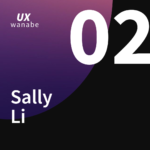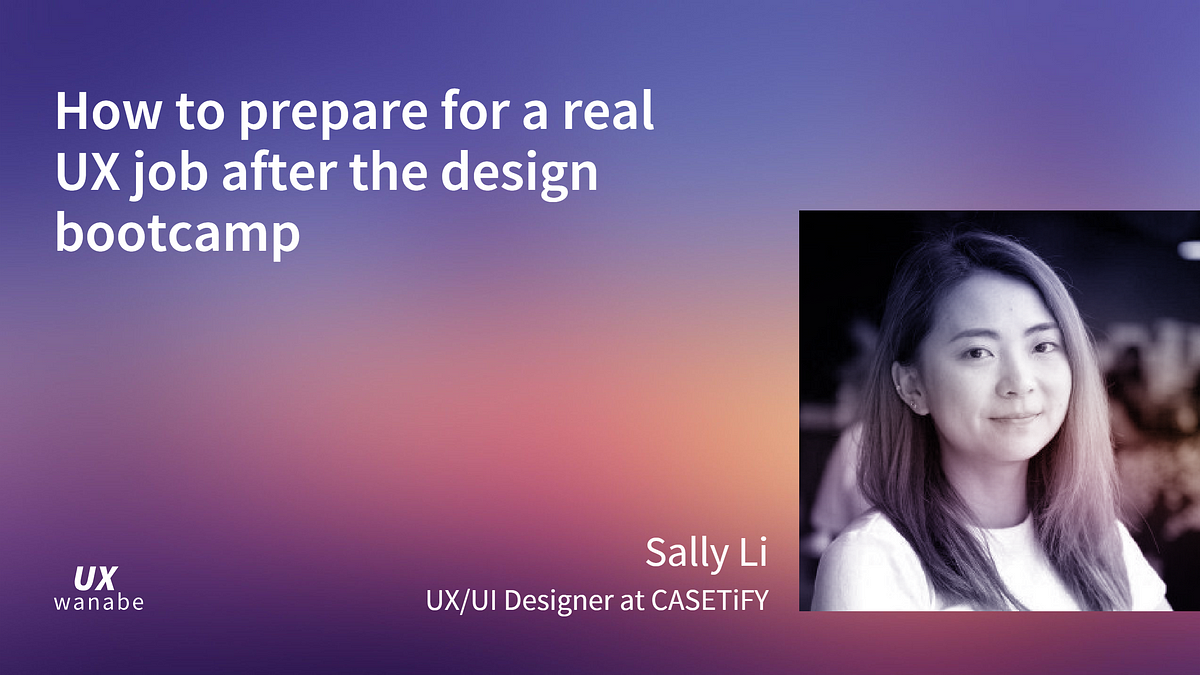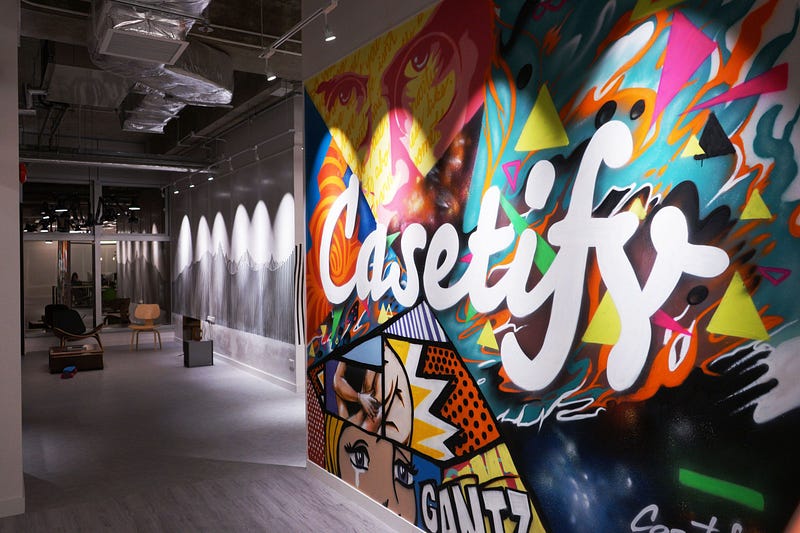

Interview with Sally Li — UX/UI Designer at CASETiFY
This article is a written summary for the second episode of UXwanabe podcast I did with Sally Li.
In the last episode, we talked about how to break into the UX field, but what happens after you broke in? How else do you need to learn? These are the topics we are going to explore in this episode with Sally Li, whom landed her first full time job in CASETiFY after graduating from a design bootcamp.
Sally is going to share her experience on:
- How she survive her first month in a startup while feeling completely overwhelmed
- How the real world is different from what the bootcamp has taught her
- How to deal with uncertainty when you don’t know the answer
- How to become more influential in the company
- Advice on people taking a design bootcamp
You can find the full recording here. Read on if you prefer the written version!
Discovering UX
How did you get into UX?
My background is in landscape architecture, I studied for five years and then worked in the landscape industry for about a year. What brought me interested in UX was I started having a few friends around me that were getting into UX design and I got curious.
I started looked into UX and was really intrigued by the design process, mostly on the end part where we keep iterating and evolving our designs to make it more user friendly. That was something I felt it was harder in a landscape built project due to time and budget reasons. So that’s how I found my way to UX and decided to leave my last job and take on a bootcamp to start my career.
Settling in
How did your first month in CASETiFY felt like?
Things moves really quick in the e-commerce industry, you also have to pick up the office culture and the way they operate much quicker than you normally would in other industries. So the first month I was honestly quite overwhelmed with the stuff I had to do, learning the different parties I have to be in communications with and prepare for their job.
It’s at that time I spoke to my mentors, as a junior designer I was quite scared going into this role without a design manager. I report directly to the head of e-commerce and that was like one of my biggest fear for first month. How do I present my idea to my manager, where I would also eventually have to directly present to the CEO himself my design rationale and why we’re doing this? How are we going to implement it? What is the timeline and all of that.
The first month I definitely reached out a lot more to the UX community to seek guidance on how I should approach my day-to-day job instead of looking for senior designer from my current company (there are no senior in my company). Also, the first month we were working remotely as well because of COVID, that made the on-boarding process a bit more tricky, I had to be a bit more independent and figure things out on my own.

What kind of help did you seek from the community?
The question I asked was how do I manage my first project. I was given a task and I felt like I didn’t know what to do. I ended up reaching out to learn how should I be thinking about and tackle this project. Advice to me at that time was: Just slow down.
Think about what is it that you’re trying to do? What resources do you need? What do you need to find out? How will you do it? Who do you need that to help you out? And that was honestly super helpful for me as a junior designer, to just have someone more senior in the design fields having to say: Calm down, it’s going to be okay.
How did you introduce the design process to your company?
I think not many companies in Hong Kong has an established process, that’s just how the UX environment is. It is like a hidden job role that part of your job as the only designer is to help the company to come up with a design process. On top of that, there’s not gonna be that many senior designers to back you up, and you’re going to have to figure it out and adjust over time.
Once I had an idea on how to do things, I spoke with the developers to figure out if what I’m trying to do is okay with them. Are we communicating clear about what the expectations are for this process? They would feed back to me and tell me to think about these other things, what is fine what is not okay…etc. As it’s a new process that I’m trying to implement with my coworkers, it requires a lot of back and forth and seeing what works and what doesn’t work, and understand what is most effective for our team.
Does everybody know what a UX designer do in your company?
My team has a good understanding of it because our Our CEO West had a design background and he is interested in having UX designer on board. However in terms of where my job begin and where it ends, it’s not as defined. For example, I’ve sometimes designed our festival logo. We do have a larger design team who are photographers animators and graphic designers, and sometimes they do that as well, but I also end up doing some of those during my day to day. I guess that’s normal for working in a startup. You need to wear a lot of hats and do a lot of things.
Theory vs Reality
How is the real world different from the design bootcamp?
There’s a pretty big difference between how the design process is taught in a bootcamp versus how it actually is in the real world. In the bootcamp they start off with user research, secondary research, interviews surveys and then get to the design phase. Although this linear process is great, it’s not always like that. You might not always start off with doing a user interview, and sometimes I feel like the boot camp can set up a bit of an unrealistic expectation when it comes to a professional workplace on how you should be executing your job.
At my job currently, due to restriction in time and resources, we don’t always do user interviews at the very beginning of our design process. We might review existing user data and process all of that with the growth team. Then we jumped into a redesign of a feature, through AB testing we test out does it work against a old version. How are people behaving with this new implementation, is it worse as better? Then we go back and keep iterating.
Do not to go into your first job and expect that you’ll be running it how you did during boot camp, and be more flexible to implement different methodologies at different times or in different projects as you go. Some companies would have the luxury to do a “proper UX design process” mainly following the bootcamps way of design more closely, but I don’t think that’s for every single company.
The bootcamp sets up a good foundation, but there’s no one size fits all solution. You need to adapt to the reality, especially with jobs in the startup environments, time and money is at stake. They’re in such a rush to monetize and grow the business. The process inevitably gets shortened or readjusted and you just have to adapt to the company’s needs and work in their fashion.

What new skills have you learned in a job that are not taught in the bootcamp?
Honestly it’s a lot of the soft skills. In my conversations with people who are interested in UX, I always bring it up to them that while part of the job is knowing how to design it in sketch and working on style guides and making sure everything looks nice, there’s also a lot of the soft skills that are involved in a UX role.
Like if you’re doing interviewing your users, the way you talk affects their results. Apart from talking to your users, the soft skills of talking to your team is also very important. As there are different stakeholders in the company, you need to become a very effective communicator.
One thing I’ve realize that’s really important is to make sure when there’s design critique, I can back my design decisions and also be a good listener to all the feedback and make sure the conversation is good between me and different stakeholders.
In terms of soft skills vs hard skills on which is more important, I feel like it’s equally, if not a bit more important to have the soft skills as a UX designer. Being able to communicate your idea and getting buy-in from different stakeholders for why we need to push for this feature or why is it valuable to the company is something you can’t do by just showing your design.
I would say that there’s not enough emphasis on softskills in the bootcamps currently, and I would definitely encourage early stage designers to also build on those skills. Also, think about how their current roles has already established that skills, and then use that to their advantage when they’re applying for new jobs to highlight how you used these soft skills and how it will help you in this role.
How do I obtain those soft-skills when I haven’t work in a real design job yet?
Finding a good mentor who’s in the field helps me reflect on my current situation and how I can do better, and they taught me how can I communicate better to my stakeholder. If you can’t find one, I think there’s so many resources out there on YouTube that teaches you how we should be talking about design and how to really get buy-ins from other people who are not in the design field to really move your design forward.
There’s also resources like the Futur that talks about the business of design and how do you present design to your stakeholders. I think the UX community is very supportive because the field is so young, and being more proactive reaching out to people or just finding resources on your own to learn is honestly the best way to get into UX.
On growing
How do you become more influential in the company?
Meeting with stakeholders more frequently. I don’t feel like I’m currently meeting with them frequently enough. Just tapping more into the questions about the different experiments that they’re running currently, what are their business goals for the next two quarters, showing them some of their designs earlier on and getting their feedback…etc. I think these kind of actions are what I can take to build more business knowledge as a UX designer.
Understanding the business is very important as a UX designer because we are supposed to be the gap between business and the user. It also helps a lot in terms of getting buy in. When you’re presenting your designs, you’re also trying to justify why they should be committing efforts and money to develop what you designed. So having that business knowledge is really key to your own career success in a company.
How would you encourage a shy designer to become more involved and understand how the business works?
I just think of my conversation with the business as a casual learning opportunity, being curious and asking them questions about how they do things.
One thing that’s very important to remind yourself is that there’s no stupid questions.
If there’s thing you don’t know, it’s okay to admit that you don’t know! You are a team with them so they’re also here to help you figure it out. Keeping that in mind should change the whole atmosphere in a conversation, it feels more relaxed, more organic. You don’t have the pressure of like needing to know, needing to meet a certain expectations. You’re okay to ask questions, you’re okay to not be an expert.
Especially for Asian people, we have this thing that we are afraid of making a fool of ourselves by asking stupid questions, but the truth is that we can’t be expert in everything. If we don’t know about marketing or we don’t know about the business, just ask. By staying humble, we are actually opening the opportunity to talk with other people and build that connection, and that’s what is important to navigate in a organization.
I had a call the other day with another UX designer who had 10 years of experience. Having heard that him admitting that “I don’t know everything. I have 10 years of experience, but I go into different industries as a UX designer without the knowledge of the industry”.
Why has it worked for him? Because he just admits that he doesn’t know and it’s okay. It’s his job to figure it out, but he doesn’t have to come in with those knowledge instilled already. That was a light bulb moment for me when I also felt a lot of relief that he is bright. I’m here as a UX designer. I am a problem solver, but I don’t have to already have the answers to everything. As long as I’m curious, I keep learning. I will get more opportunities to develop these skill sets and meet other people that can guide me in the right direction.
What else do you think would a UX designer should learn?
A bit of coding. Even just some basic understanding on coding would be helpful even though you don’t have to dive deep. It’s the language that the developers speak which you’ll definitely spend a lot of time with them, so making them feel like you can align them and befriend them will be helpful.
Closing thoughts
What advice you would give yourself a year ago when you were in the design bootcamp?
One thing I wish I had done more during my bootcamp was to get in touch with the local designers to get a better insight on what the current climate is like. I wish I did that much earlier in the process as it would’ve helped me focus more on the type of company that I wanted to join. Also, having joining and meeting the community much earlier would’ve helped clarify a lot of those questions I’ve had on the first month of my full-time position.
The other thing I’m curious is to learn more is how to host workshops. The idea of a workshop was introduced to me through AJ&Smart on YouTube. That’s when I see like the power of running a good workshop, it’s super important for aligning all the department’s needs and setting up what’s a realistic timeline for implementation.
Right now I feel like I’m stuck in between like delivering messages between different departments. I want to try to get everyone in a room to carve out one hour to talk it out and facilitate idea like brainstorming session, or prioritize all our features designs, I hope to do that within the next quarter.
Workshop does a couple of things. First you help stakeholders to align, second, which I think is actually the most important one is it helps you to establish your authority in the company. You became the center of attention by driving this thing, and bits by bits, you help to influence the company.
Workshop is also unique in the sense that no one else can do this but us. No one knows how to run a user centric workshop to figure out what’s the customer pain point and align stakeholders in a same meeting. Only trained designers know how to do that and that is our way to add value to the company.
That is something that would really benefit not just me, but the UX community as well. Just being aware of how to facilitate one, how do you set one up? How do you move people along when they’re stuck at a certain point? Sadly I don’t that that is taught enough in the Hong Kong UX scene.
How would you sell a big idea such as running a workshop to the company?
Start small, perhaps one person from design team, one person from IT, one person from marketing or business. In your first meeting, you might not be able to invite the most senior person and that’s fine. With this initial group four to five people, if you ran it well, words will spread if they see value in this kind of mini workshop.
Once you done that, document how the whole thing went, what you guys learned how this can benefit the company and then email it to everybody. If you play the cards right, other people will start to wonder what is this fun thing with post-its and whatnot, how can I join? Then step-by-step, people are open to invitation and eventually you could host like a company-wise workshop, but you need to start small. You need to start finding your ally to begin with.
END of interview.
Hope you guys enjoy reading this!
Vision for UXwanabe
My ultimate goal is to elevate the UX maturity of the Hong Kong market. A mature UX market has the follow components:
Mature UX market = Lots of mature UX organization + Lots of mature UX designers + Lots of UX opportunities
This can be achieved in 3 steps:
- Equip more people with the knowledge to become junior UX designers — This increase the talent pool.
- With increased talent pool, promising characters will emerge. For those that are willing to step up, equip them with the ability to influence their own company to become more design mature.
- As the company becomes design matured, it will produce positive results. This influences other companies to invest in UX as competitors noticed the strategic advantage of having superior user experience in their product and services. This will create more design opportunities for the market
The UXwanabe podcast plays the role of contributing to step 1 & 2 by extracting knowledge from experts and making it accessible to everyone. The podcast is just the beginning, but more is to come. Stay tuned!
If you enjoy what I am doing here, please subscribe to my news letter and share it to your friends!

